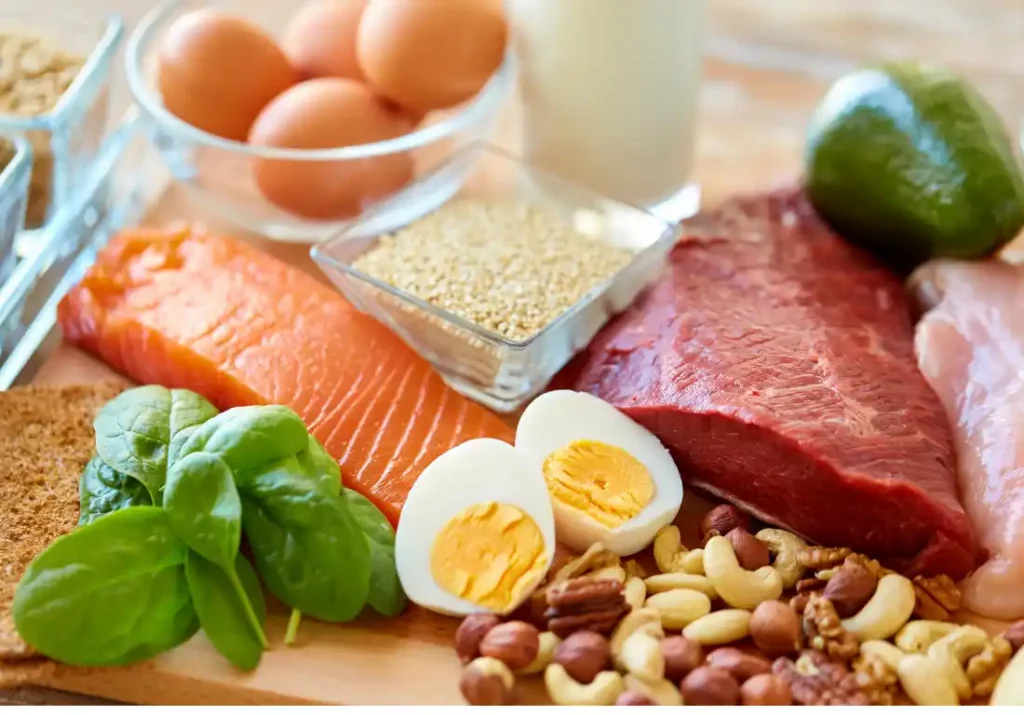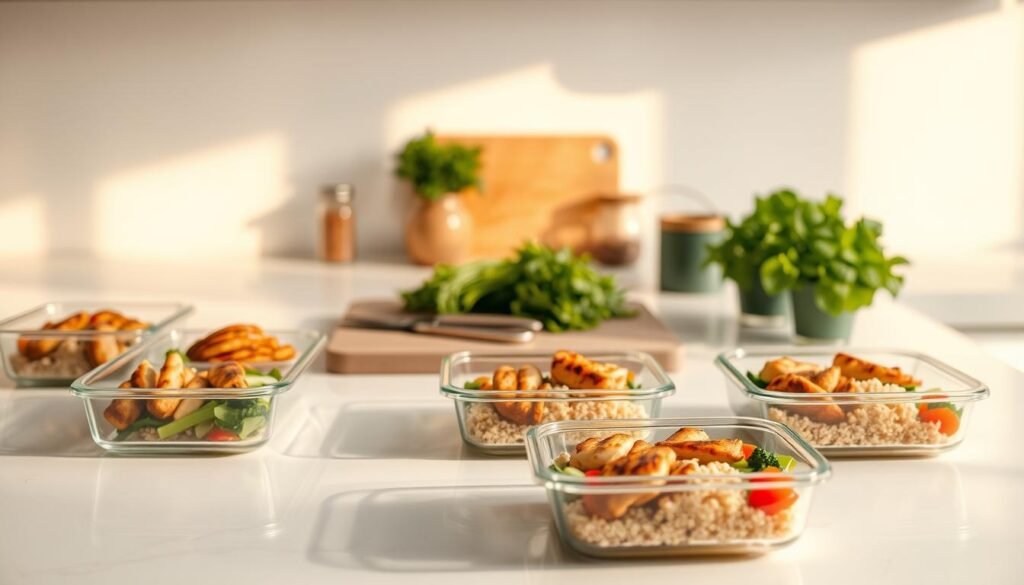Are you crushing your workouts but still not seeing the results you want? The missing link could be your diet. High protein meal prep isn’t just a trend—it’s a proven strategy for boosting weight loss, muscle gain, and staying consistent.
When you prep your meals in advance, you take control of your nutrition. You’ll save time, reduce stress, and fuel your body with the right foods at the right time. It’s one of the smartest ways to make your fitness goals stick—and this guide will show you how to make it work.

Why High Protein Meal Prep Matters
Meal prep with high protein is changing how we eat and stay fit. It lets people eat the right foods for their health and fitness goals. This way, they can keep their diet on track.
What Is High Protein Meal Prep?
High protein meal prep means planning and making meals early, focusing on protein-rich foods. It helps reach fitness goals, like losing weight or building muscle.
Protein is key for fixing and growing muscles. Eating enough protein helps meet fitness goals. Meal prep makes it simple to get enough protein every day.
| Meal Type | Protein Sources | Benefits |
|---|---|---|
| Breakfast | Eggs, Greek Yogurt | Boosts Metabolism |
| Lunch | Chicken Breast, Fish | Supports Muscle Growth |
| Dinner | Lean Beef, Tofu | Aids in Recovery |
Benefits Backed by Real Users and Science
Science and real people agree: high protein meal prep works. Studies prove it helps with weight loss and muscle gain. People say it keeps them eating healthy, avoiding bad food choices.
Adding high protein meal prep to your life brings big benefits. You’ll see better muscle, more weight loss, and better nutrition overall.
Common Struggles with Meal Prep

Meal prep has many challenges that can stop people from keeping it up. Knowing these obstacles is key to beating them.
Time and Energy: The #1 Barrier
Finding time and energy for meal prep is hard. Busy lives and tiredness make it tough to stick with it.
Storage Limitations and Fridge Chaos
Having enough space in the fridge is vital for meal prep. But, not enough room and a messy kitchen can cause stress and waste.
Tupperware Woes and Container Fatigue
Meal prep containers can sometimes be a problem. Issues like leaky containers or too many can make meal prep feel overwhelming.
Confusion About Hitting Protein Goals
Many find it hard to know how to get enough protein through meal prep. Figuring out the right amount and adding it to meals can be tricky.
| Common Meal Prep Challenges | Potential Solutions |
|---|---|
| Time Constraints | Batch cooking, prep in advance |
| Storage Issues | Organize fridge, use stackable containers |
| Tupperware Woes | Choose durable, leak-proof containers |
| Protein Goal Confusion | Use a protein calculator, plan meals around protein sources |
By understanding these common struggles and finding solutions, meal prep can become easier and more lasting.
What People Tried That Didn’t Work

You’ve probably tried meal prep before, but some methods didn’t work out. Meal prep is a personal journey. What works for one might not work for another. Knowing common mistakes can help you improve your approach.
Batch Cooking for the Entire Week
Batch cooking for the whole week might seem efficient. But it can make meals boring and less tasty. Meals from earlier in the week might get soggy or dry by the time you eat them.
Try making smaller batches for a few days at a time. This keeps your meals fresh and lets you change your meal plan easily.
Prepping Ingredients Without Assembling Meals
Prepping ingredients ahead of time saves time. But not putting meals together can cause confusion and waste time. Having pre-chopped veggies or cooked proteins helps, but putting meals together can be hard.
Prep individual parts and put meals together just before storing. This makes it easy to grab a meal when you’re in a rush.
Relying on Protein Shakes Alone
Protein shakes are convenient, but they’re not enough on their own. Whole foods have vitamins, minerals, and fiber that shakes lack.
Use protein shakes to supplement your meals, not replace them. This way, you get all the nutrients your body needs.
Overly Complex Planning Tools
Using too complex meal planning tools can be overwhelming. It’s good to have a plan, but too detailed systems can be frustrating.
Choose simple, easy-to-use meal planning tools. They should help you track macros, plan meals, and make grocery lists. Keeping it simple helps you stick to your meal prep routine.
| Common Mistake | Consequence | Better Approach |
|---|---|---|
| Batch Cooking for the Entire Week | Meals become soggy or dry | Prepare smaller batches every few days |
| Prepping Ingredients Without Assembling Meals | Confusion and wasted time | Assemble meals before storing |
| Relying on Protein Shakes Alone | Nutrient deficiencies | Use shakes as a supplement, not a replacement |
| Overly Complex Planning Tools | Frustration and discouragement | Opt for simple, intuitive planning tools |
By knowing these common meal prep mistakes, you can make your routine better. Adjust your strategy to make meal prep more effective and lasting.
What Successful Meal Prep Looks Like

Successful meal prep is about making a system that fits you. It’s tailored to your lifestyle, diet, and likes.
Fast, Streamlined Prep Sessions
One key to successful meal prep is quick and easy prep sessions. Focus on simple tasks like chopping veggies or cooking proteins in bulk.
This makes prep faster and less tiring. You can keep up with meal prep even when you’re busy.
Meals That Stay Fresh and Tasty for Days
Keeping meals fresh and tasty all week is important. Use airtight containers and labels for storage.
Also, mix up ingredients and cooking methods. This keeps your meals exciting and prevents boredom.
Flexible Systems That Accommodate Real Life
Life is full of surprises, and meal prep should be flexible. Have a backup plan, like a slow cooker, for unexpected changes.
This flexibility reduces stress. You can stay on track with your diet, even on tough days.
Meals That Hit Macros Without Confusion
Successful meal prep means meals that meet your macronutrient needs easily. Use a meal planning app to track your macros.
Focus on meals that are full of nutrients. This fuels your body for top performance and health.
Core Benefits of High Protein Meal Prep
High protein meal prep does more than just help you gain muscle and lose weight. It brings many benefits that improve your health and fitness.
Saves Time and Reduces Weeknight Stress
One big plus of high protein meal prep is saving time during the week. You don’t have to think about what to eat or cook every day. This makes meal planning easier and less stressful on weeknights.
Promotes Muscle Repair and Growth
It’s great for those who want to build or repair muscle. Protein is key for muscle recovery and growth. With high protein meals, you can reach your fitness goals, whether you’re an athlete or just like to work out.
Helps With Weight Loss and Calorie Control
High protein meal prep also helps with weight loss and controlling calories. Protein takes more energy to digest than carbs or fat. This can boost your metabolism and help you burn more calories. So, it’s good for managing your weight and getting a healthier body.
Other Key Benefits
- Keeps you full and fights cravings
- Supports overall health and wellness
- Can be tailored to suit various dietary needs and preferences
Knowing the main benefits of high protein meal prep helps you make better choices for your diet and fitness. It’s useful for losing weight, building muscle, or just eating better. High protein meal prep is a great tool for your journey.
Your High Protein Prep Strategy (Step-by-Step)
Starting your fitness journey is easy with a good high protein meal prep plan. We’ll guide you through each step. This includes meal planning, picking the best proteins, batch cooking, and balancing your meals for the best nutrition.
Start With Planning: Meals, Macros, and Shopping
Good meal prep starts with a solid plan. First, pick your meals for the week. Think about your fitness goals and what you can eat. Then, figure out your macros to hit your protein goals. Make a shopping list to avoid buying too much and wasting food.
- Determine your daily protein needs based on your fitness goals.
- Plan your meals around lean proteins, complex carbohydrates, and healthy fats.
- Create a shopping list to stay organized.
Choose Lean Proteins for Your Goal
Picking the right proteins is key for your meal prep. Go for lean proteins like chicken breast, fish, tofu, or legumes. These help build and repair muscles without too much fat.
Use Batch Cooking and Smart Tools
Batch cooking saves time by making many meals at once. Use tools like slow cookers, instant pots, or meal prep containers to make it easier. This method saves time and keeps your meals consistent.
- Use a slow cooker to prepare meals that simmer all day.
- Invest in a good quality instant pot for quick cooking.
- Utilize meal prep containers for easy storage and reheating.
Balance Meals With Carbs, Fats, and Fiber
A balanced meal is important for your fitness goals. Make sure your meals have carbs, fats, and fiber. This mix gives you energy, keeps you full, and is good for your health.
| Nutrient | Examples | Benefits |
|---|---|---|
| Complex Carbohydrates | Brown rice, quinoa, sweet potatoes | Provides sustained energy |
| Healthy Fats | Avocado, nuts, olive oil | Supports heart health and satiety |
| Fiber-Rich Foods | Vegetables, fruits, legumes | Aids digestion and supports healthy blood sugar levels |
Meal Prep Ideas by Category
Boost your meal prep with our wide range of recipes. We have everything from high protein breakfasts to healthy snacks. You’ll find what you need here.
Breakfasts With 30g+ Protein (Eggs, Oats, Yogurt)
Start your day with a protein-packed breakfast. This keeps you full and focused. Try making:
- Scrambled eggs with turkey sausage and avocado
- Greek yogurt with berries and almond butter
- Overnight oats with protein powder and nuts
These breakfasts are not just high in protein. They’re also full of nutrients to keep you going all morning.
Lunches to Power You Through the Day
For a filling lunch, prep:
- Grilled chicken breast with quinoa and roasted vegetables
- Turkey and avocado wraps with mixed greens
- Lentil soup with whole grain bread
These lunches are both nutritious and filling. They help you stay energized all day.
Dinners That Satisfy and Support Recovery
Dinner is key for recovery, after a workout. Make:
- Baked salmon with sweet potato and green beans
- Grilled chicken with brown rice and steamed broccoli
- Beef stir-fry with mixed vegetables and quinoa
These dinners are tasty and full of nutrients. They support muscle recovery and overall health.
High Protein Snacks for Cravings and Energy
Need a quick snack? Try:
- Cottage cheese with fruit
- Hard-boiled eggs
- Protein bars made with wholesome ingredients
These snacks are high in protein. They help control cravings and give you a boost of energy.
Adjusting for Your Goals and Lifestyle
To get the most out of your meal prep, it’s key to make it fit your goals and lifestyle. Whether you want to lose weight, gain muscle, or follow a special diet, your meal prep should match your needs.
Weight Loss: Lower Calorie, High Protein Focus
For weight loss, aim for a calorie deficit. Keep your protein high to save muscle. Eat lean proteins like chicken, fish, and tofu. Pair them with veggies and whole grains.
Muscle Gain: Higher Carbs and Caloric Surplus
To gain muscle, you need more calories than you burn. Eat more carbs to fuel workouts and grow muscles. Make sure you get enough protein to repair and build muscle.
Special Diets: Vegan, Gluten-Free, Dairy-Free
Meal prep can be adjusted for special diets like vegan, gluten-free, and dairy-free. Vegans should eat plant-based proteins like legumes and tofu. Choose gluten-free grains like quinoa and rice for gluten-free diets. For dairy-free diets, use non-dairy milk and dairy-free proteins.
Budget Meal Prep With Maximum Protein
Meal prep doesn’t have to be expensive. To save money, buy in bulk, plan meals with seasonal produce, and pick affordable proteins like beans, eggs, and canned tuna.
By adjusting your meal prep to fit your goals and lifestyle, you can see better results and make lasting changes.
Conclusion: Build a System That Works for You
Creating a meal prep system that fits your needs is key to reaching your fitness goals. Understanding the value of high protein meal prep is important. It helps you save time, reduce stress, and move closer to your goals.
To build a meal prep system that suits you, plan well and stay flexible. Choose the right proteins and balance your macros. Also, prep meals that match your lifestyle. This way, healthy eating becomes a lasting part of your routine.
A meal prep system that’s tailored to you meets your dietary needs and preferences. Focus on what works best for you. This makes your system effective and enjoyable, helping you stay on track and reach your goals.
FAQs
What is high protein meal prep, and how does it help with weight loss and muscle gain?
High protein meal prep means preparing meals in advance that are rich in protein. It supports muscle growth and fat loss by keeping you full longer, fueling workouts, and making healthy eating more consistent.
How do I plan my meals and macros for high protein meal prep?
Start by calculating your daily protein needs based on your weight and fitness goals. Then build meals using lean proteins, healthy fats, complex carbs, and fiber-rich vegetables to hit your macros.
What are common mistakes in high protein meal prep?
Many people overcook large batches of the same food, rely only on protein shakes, or make prep too complicated. Keeping it simple, varied, and realistic boosts long-term success.
How can I keep my meal prep fresh and tasty all week?
Use airtight containers and refrigerate or freeze meals as needed. Reheat gently, and consider prepping ingredients separately to keep meals crisp and flavorful longer.
What are the best high protein meal prep ideas for breakfast, lunch, dinner, and snacks?
Try egg muffins, protein oats, or Greek yogurt for breakfast. Lunch and dinner ideas include chicken and quinoa bowls, salmon with veggies, or lentil salads. Snacks like hard-boiled eggs, cottage cheese, or roasted chickpeas keep protein intake up between meals.
How do I adjust my meal prep for weight loss vs. muscle gain?
For weight loss, focus on lower-calorie, high-protein meals with fiber. For muscle gain, increase calories with added carbs and healthy fats while keeping protein intake high.
Can I do high protein meal prep on a budget?
Absolutely. Use affordable protein sources like eggs, canned tuna, lentils, and beans. Buy in bulk, plan around weekly sales, and stick to seasonal produce to cut costs.
How do I store meal prep containers to save fridge space?
Choose stackable, compartmentalized containers to organize meals efficiently. Label them by day or meal type and freeze extras flat when possible.
What are the best ways to reheat meal prep without ruining the texture?
Use a microwave-safe lid or damp paper towel to retain moisture. For better texture, reheat in a skillet or oven on low heat to crisp up proteins and veggies.
How do I avoid meal prep burnout or food boredom?
Rotate protein sources and try new recipes weekly. Use different herbs, spices, or sauces, and prep base ingredients for mix-and-match flexibility throughout the week.
Is it safe to eat prepped meals for 5 days?
Yes, if stored properly. Keep meals in airtight containers, refrigerate immediately, and consume within 3–5 days. For longer storage, freeze meals and reheat thoroughly before eating.
Can high protein meal prep help control cravings?
Yes, protein increases satiety and stabilizes blood sugar, which helps reduce cravings and prevent overeating—especially during weight loss phases.
Do I need protein powder for meal prep?
No, it’s optional. Whole food proteins like eggs, meat, tofu, beans, and Greek yogurt work well. Protein powder is convenient but not necessary for hitting your goals.
Why does my meal prep taste bland or dry?
This is common. Add flavor with herbs, spices, citrus, and low-calorie sauces. Avoid overcooking, and store dressings separately to maintain texture and taste.
I have ADHD—how can I make meal prep easier?
Use simple routines like prepping just 2–3 proteins and sides. Break tasks into short blocks, label containers clearly, and use reminders. Prepping in stages can reduce overwhelm.

